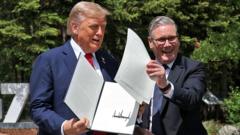The first polls have closed in a consequential Canadian election that will shape the nation’s response to looming challenges, including President Trump's trade threats. Voters are choosing between the Liberal Party, under Prime Minister Mark Carney, and Conservative leader Pierre Poilievre, as well as other smaller parties, in a battle marked by shifting public opinion.
Canadians Head to Polls Amidst Turbulent Political Climate

Canadians Head to Polls Amidst Turbulent Political Climate
As Canada's general election unfolds, voters are set to decide who can navigate the country through its most pressing challenges, with Liberal Prime Minister Mark Carney and Conservative leader Pierre Poilievre in contention.
As the sun sets on April 28, Canadians are casting their votes in an election laden with significance, in response to a rapidly changing political landscape shaped by external pressures, including President Trump’s aggressive trade policies. Polling stations closed at staggered times across the country, culminating in the latest updates reflecting shifting public support.
In the lead-up to this election, the Conservative Party had seen a significant lead in polls, boasting over a 25-point advantage. However, the resignation of former Prime Minister Justin Trudeau and the new threats posed by Trump transformed the electoral narrative. Now, Prime Minister Mark Carney of the Liberal Party has gained momentum, contending with Pierre Poilievre for the prime ministership, a position determined by which party secures the most parliamentary seats.
Three other parties are vying for influence: the New Democratic Party (NDP), the Greens, and the Bloc Québécois, the latter primarily seeking Quebec's sovereignty. The electoral process allows Canadian citizens to vote for local representatives in their districts — a significant feature of the parliamentary system.
Mark Carney, a former central banker, faces off against Poilievre, a career politician closely aligned with Trump's ideologies, despite some voter apprehension regarding the parallels in their tactics. Meanwhile, smaller parties are working within their niches, primarily focusing on local concerns, issues of sovereignty, and environmental policies, all but overshadowed by the dominant concerns regarding U.S. trade impacts.
Voter sentiment shifted dramatically from pre-election predictions, revealing an electorate weary of the trade war rhetoric and its implications for Canada's economy, which has undergone significant turmoil in recent months. The elections also present climate considerations, albeit secondary, framed by a backdrop of economic distress and opposition to Trump's presidency.
Elections Canada, the independent authority overseeing this election, faced technical difficulties that temporarily impeded access to voting information and results. Voter turnout during early voting significantly increased, indicating heightened engagement amid the political uncertainty that has permeated the national discourse.
As the night unfolds, Canadians await the first results, which have been largely anticipated due to the significant implications this election holds for Canada's future amidst global predicaments deeply influenced by U.S. policy. With every vote cast, the narratives of leadership, accountability, and resilience continue to resonate through the halls of Canadian governance.





















